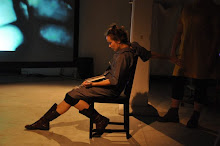Last Thursday I stepped out for a little late-night Maxwell Davies. Back in 2005, the International Contemporary Ensemble developed a reading of Eight Songs for a Mad King with director Lydia Steier. Last week's resurrection of the same production took place at the hip new Poisson Rouge in Greenwich Village (what is it about venues with color-coded animal names? Remember the White Dog Café?) Fortunately for me, Eight Songs, which was wild and incendiary when it was written in 1969, is still weird enough in 2009 that hip young groups like I.C.E. are willing to take it on. I have yet to be underwhelmed by these folks, who pulled off Xenakis's bizarre Oresteia last year at the Miller Theater with what I can only call style. For the Davies, they actually went to the trouble of memorizing the score. So it was somewhat disappointing that in spite of such a colossal feat, the instrumentalists were deliberately sidelined in the production by the King's antics.
Davies' idea for the original production had the King (modeled on King George III, the sole singer in the score) interacting on stage with each of the instrumentalists, who are all in cages, representing the bullfinches that crazy George III allegedly played with during his 60 odd years of royal insanity and seclusion. There are no cages in Steier's production. And the question of whether the King is performing at all (is he performing nuts, or is he just nuts?) is updated into the psycho-scape of the ultimate vanity press: YouTube. The instrumentalists crouch on either side of a giant stage-size screen onto which the King's singing face is projected. The King himself sits behind the screen (we cannot see him, but we hear his voice), but the liveness of his performance is belied by the intervention of a camcorder. What we see is much less like a performance, and more like a blown-up home video of a guy screwing around in his bedroom.
Steier's conceit is that the singer gradually makes himself up as King George. Over the course of roughly 45 minutes, he applies a generous white base, pencils in eyebrows and beauty marks, does up his lips, and finishes off the costume with a powdered wig (which he powders, hilariously). Partly because of the making-up bit, and partly because much of the vocal part lies in a falsetto range, the effect is a bit like Dame Edna after five tequila jello shots. Peter Tsantis is a creditable singer and his rendition is not coincidentally very singerly. He has exceptional technique and despite all the noisy racket he's required to make didn't appear to be straining. The problem is that without the sense of geniune strain, the sense of genuine madness flies out the window. Other interpreters of the role (Roy Hart or Julius Eastman), have voices that seem literally to come apart as the King's reality comes apart. With Tsantis, I wasn't on the edge of my seat. (Although that may also have been due to the unwelcome narration from the man behind me who felt obliged to fill in long and goofy explanations for the benefit of his young girlfriend: "Now, you know which one's the cello, right? ... Oh, this bit's from the Messiah! Do you know the Messiah?" I turned around at one point to ask him if he'd like to step outside to fight, but came face to face with a waitress presenting him and his girl-teen with an enormous Lobster Crostini plate. Don't go to the Poisson Rouge if you like your voyeurism without the annoying chatter.)
If you're familiar with the piece, you know that the King has to emerge from under the screen at some point because there's the bit about him breaking the violinist's violin. He does eventually come out, appearing onstage in the flesh for the first time. This ought to be a big moment and it is. The screen is simply a backdrop now, and we're in the familiar world of theater. The King dutifully smashes the violin. But then, oddly, Steier has him return behind the screen, and finish the rest of the piece from there. In retrospect, the entrance onstage appears not to have been an interesting staging choice (shattering the YouTube illusion and replacing it with real-time theater), but merely the shortest way to get the King and the violin close enough for the one to beat the other into submission. The problem is that having once tossed out the YouTube conceit, it makes no sense to have the singer step behind the screen again. Once we know that the Wizard of Oz is the guy behind the curtain, he has to stop doing the schtick behind the curtain and come out and face his audience like a man. Or a queen.
There was also very little ... no, I'm gonna go with no attempt made to integrate what was happening on stage with Randolph Stow's lyrics, which are thoughtful, bizarre and strong, and which will contradict what you're doing if you're not careful. (Why would this particular King, dressing up as a woman, suddenly start raving about Esther, his queen? Whoops!) I'm all about artistic license, but if there's no attempt to align what's going on action-wise with what the King is saying, it becomes Eight Mumbles for Some Sick Sonofagun, which isn't half as interesting as what's printed in the score.
I'd still tell you to go see it, but that was the only performance. Next time.
Subscribe to:
Post Comments (Atom)




No comments:
Post a Comment